14+ SAMPLE Film Sponsorship Proposal
-
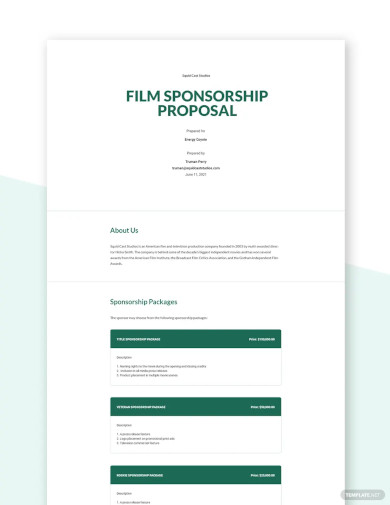
Film Sponsorship Proposal Template
download now -

Documentary Film Sponsorship Proposal
download now -
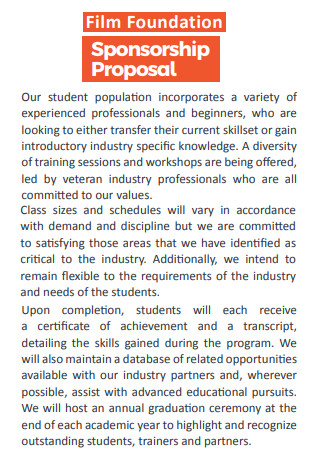
Film Foundation Sponsorship Proposal
download now -

Film Festival Sponsorship Proposal
download now -
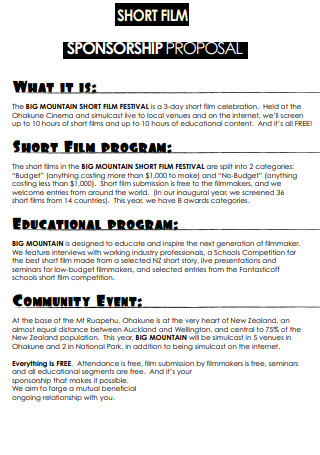
Short Film Sponsorship Proposal
download now -
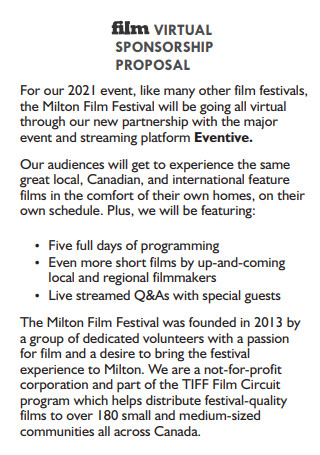
Virtual Film Sponsorship Proposal
download now -
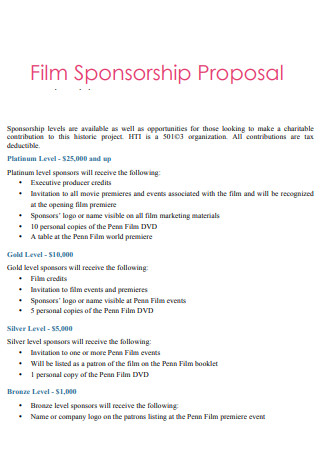
Film Sponsorship Proposal
download now -
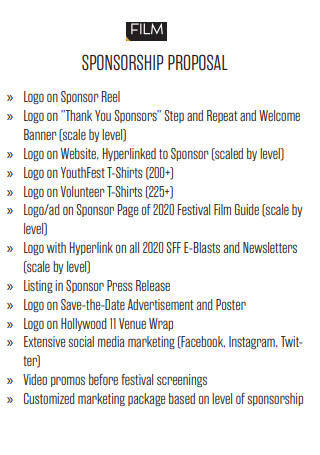
Sample Film Sponsorship Proposal
download now -

Indigenous Film Sponsorship Proposal
download now -

Film Makers Sponsorship Proposal
download now -
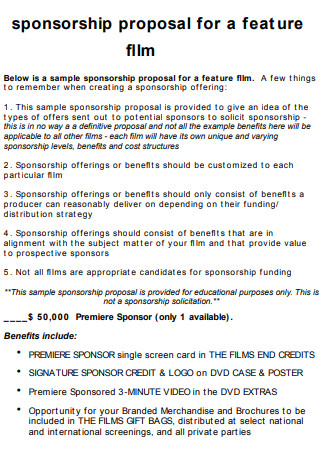
Featured Film Sponsorship Proposal
download now -
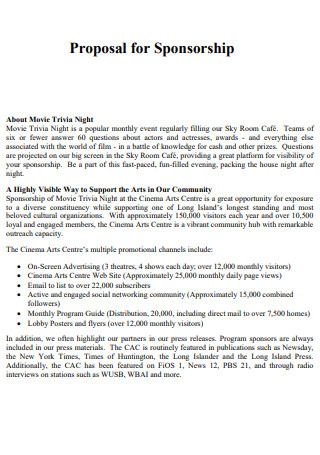
Movie Sponsorship Proposal
download now -

New Film Sponsorship Proposal
download now -
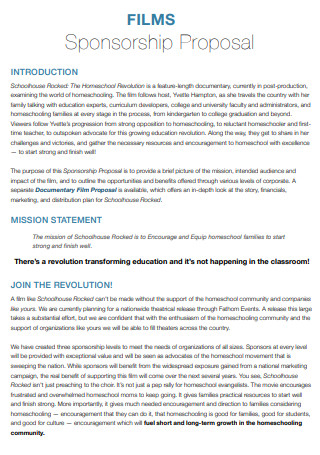
Standard Film Sponsorship Proposal
download now -
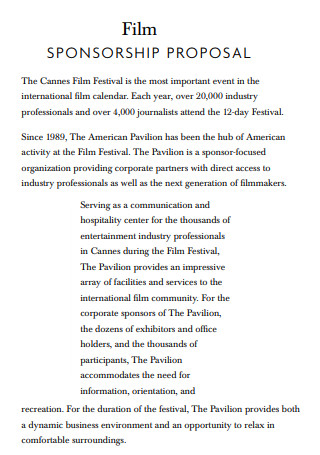
Film Sponsorship Proposal Example
download now
FREE Film Sponsorship Proposal s to Download
14+ SAMPLE Film Sponsorship Proposal
What Is a Film Sponsorship Proposal?
Different Types of Film Genres
Things You Consider before Writing a Film Sponsorship Proposal
How to Write a Film Sponsorship Proposal
FAQs
What is fiscal sponsorship?
How long should a film sponsorship proposal be?
What is the process of getting sponsored by a film festival?
What Is a Film Sponsorship Proposal?
A film sponsorship proposal is a proposition sent by one individual or organization to another entity in the hopes of forming a partnership. A partnership seeker, also known as a sponsee, must persuade the investor or sponsor of the film project’s worthiness in this document. There are various companies or organizations willing to sponsor the production of the film. Through a proposal, sponsors are able to get the rundown of the film. The best way to convince them is to make use of a film sponsorship proposal template. Continue reading the article to follow through with the guide.
Different Types of Film Genres
Film genres are classifications that categorize films based on their narrative aspects. The types of plots told by each genre are distinct. Subgenres have emerged as genres have altered and evolved, further defining filmmaking approaches. It is relevant to know the different types of films since not only will they help filmmakers pursue their visions but will aid the proposal to be realized by the readers and even the sponsors. Aldredge of Premium Beat gave a thorough list that has been collected and summarized in this article for aspiring film artists and makers to be aware of.
Things You Consider before Writing a Film Sponsorship Proposal
In filmmaking, screenwriting is not the only type of writing that is necessary. You will need to compose a movie sponsorship pitch to attract sponsors or investors once you have finished your script, treatment, and even shot list. There will be no film if there is no money. A sponsorship proposal is similar to a love letter to a film that has yet to go into production, except that you must demonstrate your passion and the quality of your movie to a potential investor in this document. Though there is no standard template or framework for such proposals, the following items must be included.
How to Write a Film Sponsorship Proposal
When determining how to draft a sponsorship proposal for a film, it may be necessary to include certain aspects while excluding others. When crafting a proposal for a specific sponsor or investor, this is especially true. It’s crucial to target the investor and present the concept in a way that they will like. Remove anything that isn’t absolutely required. You want to make the procedure as simple and convenient for the other party as possible. As a result, it is critical to adhere to their instructions or regulations and to demonstrate that you appreciate their intentions.
1. Prepare the Outline of your Film
While there is no one-size-fits-all approach to developing a script outline, there are certain guidelines to follow. You may utilize some tried-and-true methods to aid your mental process. Also, make a list of all the crucial details in your script. The goal of learning how to develop a script outline is to organize the path of your character. In such a way that your sponsor or reader will be able to connect with the tale, engage with it, and enjoy it without feeling overwhelmed or bewildered.
2. Have a Logline and Title
A logline is a one or two-minute elevator pitch that determines whether or not a producer will flip the page and read your screenplay. The elevator pitch is everything when it comes to summarizing a film with a logline. This is your sample brief, no-frills chance to tell us about your script. Loglines pique the reader’s interest and direct them to the story’s core conflict. Simply said, a logline is a brief, attention-getting remark that promotes the script. Your logline serves as a succinct and clear preview of your film. You should also prepare appealing titles that can entice the sponsors.
3. List the Crew Members
An investor is always interested in learning more about the individuals in whom they are putting their money. Introducing your staff instills trust in your abilities and project. Give them a nice introduction, but don’t brag or compliment yourself on the back. That does not sit well with anyone. Keep it short and direct, but enough to satisfy or entice the readers to the various members involved in producing your film. Prepare the list of names of the director, producer, and other members of your crew.
4. Draft a Project Timeline
For the fourth step, you will need to include the timeline chart of the film you have in mind. This includes the different stages or phases of the film, namely the pre-production, production, and post-production. You will need to give the sponsors or investors a rundown on the process of your film.
5. Create a Project Budget
Even if many details haven’t been decided, you will need a ballpark number to tell the investor how much the project will cost in an estimate. Of course, the numbers will fluctuate, but the investor must choose whether you, your team, your plot, and your abilities are worth their time. So, as thoroughly as possible, break down your film budget and provide your investor with an estimate of how much you intend to get.
6. Have Audience Data
The most crucial aspect of a film is its audience. So you describe the film’s target demographic and any marketing methods you have in mind for them here. Allowing investors to know that you are eager to recoup their investment earns their trust. One thing that will convince sponsors to pursue your film is your acknowledgment and awareness of the audience analysis that your film could cater to.
FAQs
What is fiscal sponsorship?
Fiscal sponsorship is a partnership proposal between an established nonprofit organization and an individual or entity that does not have the legal status required to receive grants from foundations, individual donors, or government agencies. The most obvious advantage of fiscal sponsorship is that individuals may obtain philanthropic money for their projects without having to go through the time-consuming and costly process of forming an organization. This is true for independent filmmakers, who rarely need to establish up a charity for a specific production.
How long should a film sponsorship proposal be?
A film sponsorship proposal usually lasts between two to three pages since most sponsors and investors won’t have the entire day to leisurely go through various pages of the document nor to listen to an hour-long pitch. It is much better to be direct and concise.
What is the process of getting sponsored by a film festival?
Almost every large event producer understands that sponsorship is critical to increasing the event’s visibility, legitimacy, and finance. Building good relationships with donors who are interested in opportunities inside the industry is the goal of film festival sponsorship. Check out the film festival sponsorship proposal available that you can use or if you are going for a documentary style, you can proceed to documentary film sponsorship proposal examples.
Never submit a film proposal that was not created with the reviewer in mind. You should always do your study and tailor the proposal to the reviewer if you know who you are submitting to. Over time, as you learn how to draft a film production proposal, you will have a better understanding of what it takes to get proposals past the corporate sponsorship and secure the funding you require. If your suggestion is rejected, it’s not a bad idea to inquire as to why. Get started on writing that film sponsorship proposal letter now!
